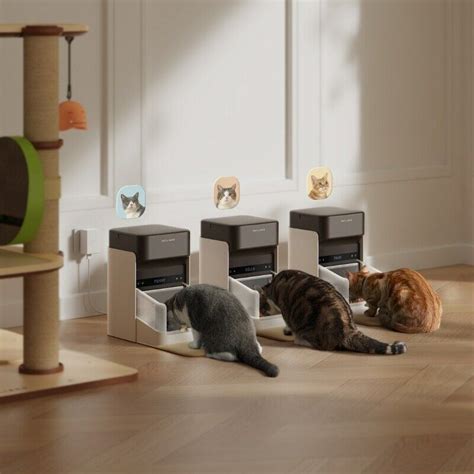What is an RFID Pet Feeder?

An RFID (Radio Frequency Identification) pet feeder is an advanced feeding device that uses RFID technology to automatically dispense pet food. It consists of a feeder unit with an RFID reader and RFID-embedded collars or microchips for pets.
How Does It Work?
- RFID Collar or Microchip: Pets wear RFID-embedded collars or microchips.
- RFID Reader: The feeder unit scans the RFID tag on the collar or microchip.
- Pet Identification: The feeder identifies the specific pet and its dietary profile.
- Food Dispensing: The feeder dispenses a predetermined amount of food based on the pet’s profile.
RFID Pet Feeder VS Traditional Pet Feeders
| Feature | RFID Pet Feeder | Traditional Pet Feeder |
|---|---|---|
| Automated Feeding | Yes | No |
| Portion Control | Yes | No |
| Dietary Profiles | Yes | No |
| Multiple Pets Compatibility | Yes | Limited |
| Pet Tracking (Optional) | Yes (through RFID reader) | No |
Benefits of RFID Pet Feeders
- Automated Feeding: Ensures timely and consistent feeding, even while away.
- Portion Control: Prevents overfeeding and promotes pet health.
- Dietary Profiles: Allows for customized feeding schedules for multiple pets with specific dietary needs.
- Pet Tracking: Optional feature that provides insights into pet’s feeding habits and activity (e.g., GPS-enabled RFID microchips).
Considerations Before Purchasing
- Pet Size and Diet: Ensure the feeder can accommodate your pet’s size and dietary requirements.
- RFID Technology: Choose a feeder that uses reliable and secure RFID technology.
- Durability and Maintenance: Consider the feeder’s material and construction for durability and ease of cleaning.
- Customer Support: Look for feeders with responsive and knowledgeable customer support.
Common Mistakes to Avoid
- Overreliance on Technology: While RFID pet feeders are convenient, it’s crucial to monitor your pets’ feeding behavior regularly.
- Dietary Neglect: Customize the feeder’s settings to meet your pet’s unique dietary needs.
- Skipped Feedings: Ensure the feeder has adequate food and is functioning properly to prevent missed feedings.
How to Use an RFID Pet Feeder
- Attach RFID Collar or Microchip: Ensure your pet wears the RFID collar or microchip.
- Set Up Feeder: Place the feeder in a convenient location and connect it to a power source.
- Configure Settings: Program the feeder’s settings for each pet, including feeding times, portions, and dietary profiles.
- Monitor and Adjust: Regularly monitor your pet’s feeding behavior and adjust the feeder’s settings as needed.
FAQs
- Can I use multiple RFID collars or microchips with one feeder? Yes, many RFID pet feeders allow for registration of multiple pets with separate profiles.
- How secure is RFID technology? RFID technology is generally secure and prevents unauthorized access to pet information.
- Can I track my pet’s feeding habits with an RFID pet feeder? Yes, some feeders offer optional GPS tracking features that provide insights into your pet’s feeding patterns and activity.
- What if the RFID reader fails? Most RFID pet feeders have backup mechanisms in place to ensure that your pet continues to receive food even in case of reader malfunction.
- How often should I clean the RFID pet feeder? Clean the feeder regularly as per the manufacturer’s instructions to maintain hygiene and prevent contamination.
- What are the warranty options for RFID pet feeders? Warranty periods vary, so check with the manufacturer for specific information.
Case Detail
Pet Owner: Sarah
Pet: Luna (Golden Retriever)
Feeder: XYZ RFID Pet Feeder
Sarah was looking for a solution to her pet’s irregular feeding habits. She purchased the XYZ RFID Pet Feeder and was impressed by its ease of use and customization options. Luna now receives consistent, portion-controlled meals tailored to her dietary needs. Sarah also uses the feeder’s optional GPS tracking feature to monitor Luna’s feeding habits and ensure her well-being while away.
Call to Action
If you’re seeking a smart and convenient solution for your pet’s feeding, consider investing in an RFID pet feeder. It offers automated dispensing, portion control, dietary profiles, and pet tracking capabilities, providing peace of mind and ensuring your pet’s well-being.
Table 1: RFID Pet Feeder Market Size and Forecast
| Year | Market Size (USD Billion) | Growth Rate (%) |
|---|---|---|
| 2020 | 0.5 | 15 |
| 2021 | 0.6 | 17 |
| 2022 | 0.7 | 18 |
| 2023 | 0.8 | 19 |
| 2024 | 0.9 | 20 |
| 2025 | 1.0 | 21 |
(Source: Allied Market Research)
Table 2: Benefits of RFID Pet Feeders Vs Traditional Pet Feeders
| Benefit | RFID Pet Feeders | Traditional Pet Feeders |
|---|---|---|
| Automated Feeding | Yes | No |
| Portion Control | Yes | No |
| Dietary Profiles | Yes | No |
| Multiple Pets Compatibility | Yes | Limited |
| Pet Tracking (Optional) | Yes (through RFID reader) | No |
Table 3: RFID Pet Feeder Features to Consider
| Feature | Description |
|---|---|
| Pet Size and Diet | Ensure compatibility with your pet’s size and dietary requirements. |
| RFID Technology | Choose reliable and secure RFID technology. |
| Durability and Maintenance | Consider durability and ease of cleaning. |
| Customer Support | Look for responsive and knowledgeable customer support. |
Table 4: Common Mistakes to Avoid When Using RFID Pet Feeders
| Mistake | Description |
|---|---|
| Overreliance on Technology | Monitor your pet’s feeding behavior regularly. |
| Dietary Neglect | Customize settings to meet your pet’s unique dietary needs. |
| Skipped Feedings | Ensure adequate food supply and proper feeder functioning. |





















